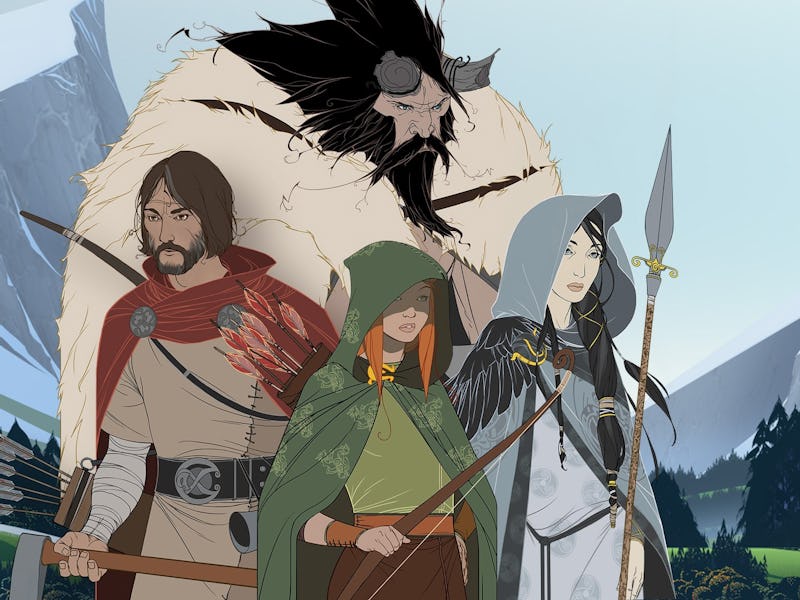It’s Time To Stop Ignoring The Best RPG Trilogy Since Mass Effect
10 years ago, one crowd-funded game found excellence in execution.

We’re never satisfied with perfection. Perfect things are rarely given more than a moment to exist. They’re almost always seen as “the right thing at the right time.” Perfection is never allowed much staying power because we expect iteration and improvement, especially for something as commercial as gaming. There’s always room for more pixels, better lighting, or bigger maps. But every once in a while though, something perfect and timeless comes along.
Ten years ago, that was The Banner Saga Trilogy.
The first game in the series, The Banner Saga, arrived on January 14, 2014. Developed by Stoic Studio, a small team mostly made up of former BioWare employees, it began with a Kickstarter campaign. More than 20,000 backers raised $723,000, far surpassing their goal of $100k. It’s easy to see why it was successful: stunning visuals that invoke the work of Disney legend Eyvind Earle, a Norse-inspired setting, and a gameplay balance that’s a mix of XCOM, Dragon Age, and Oregon Trail.
The Banner Saga follows a group of survivors as they navigate the literal end of the world, evidenced by the return of a mythical serpent so large it can devour mountains. Players step into the dual roles of the hunter Rook and his daughter Alette as they reluctantly lead hundreds in the search for safe haven. They hope it will come at the mighty hands of the Varl, an ancient race of ageless giants who have brokered an uneasy peace with humans. You soon learn that no one is safe.
From the beginning, the character work and narrative branches are sublime. As the game and its subsequent sequels unfold, you will add dozens of characters to your roster. Every single one has a distinct story to tell, as well as unique attributes to aid you in battle.
TFW you realize everything’s changed.
To add even more stakes, the end of the world has also woken the Dredge, a mysterious race of automatons slaughtering everything in their path. You’ll fight them often. What do the Dredge want? No one knows.
We do know that fighting them is an awful lot of fun, so long as you’re a fan of tactical, turn-based combat. The Banner Saga implements a unique system where each character has two stats: strength and armor. Strength pulls double-duty as both life and attack power. So every time you take damage, you get a little weaker. Armor helps mitigate this, so the strategy revolves around fielding warriors powerful enough to destroy armor quickly or bypass it with special attacks. There’s dozens of special abilities and some magical equipment in the mix, too.
Two sequels deliver more of the same: The Banner Saga 2 (2016) and The Banner Saga 3 (2018). All three games earned an average of 81 on metacritic, a respectable score but one that doesn’t reflect the level of execution on display. As you play through the trilogy it becomes clear how everything works towards the purpose of immersing you in the weight of its world. Every character has a motive. Every battle feels important. Every decision does, too — and there are a lot of them. You’ll spend hours watching your caravan from a distance, slowly trekking through some of the most breathtaking level design ever created.
Gorgeous scenes like this are everywhere in The Banner Saga.
All that walking is hungry work. In addition to regular skirmish with the Dredge, you’re also challenged by an ever-dwindling food supply and company morale. When you’re fortunate enough to find an encampment that offers shelter and supplies, you’ll have to make tough choices with the currency you have to spend. The Banner Saga understands the wartime refugee experience isn’t limited to fighting, and the toughest battles happen over deciding who gets what when there isn’t enough of anything to go around.
Random encounters, like bandits and mystical shrines, will also test your resolve. There’s no permadeath in combat, but there is permadeath in the decision trees. Make the wrong choice and you may seal the fate of your favorite character. It may not happen immediately, either. The Banner Saga games have long memories, and a high replay value as a result.
Decisions are not limited to one or two options. You’ll always have a lot to think about (and a lot to doubt).
What makes these games perfect is their totality. As the story advances so do the characters. Play all three in a row and you’ll find yourself fighting alongside allies who’ve been there since the first battle — if they’re lucky enough to make it. The aesthetics, music, narrative, and gameplay all coalesce around the central themes of resilience, sorrow, and hope.
It’s remarkably consistent; a singular vision seen through from start to finish. Sure, you can point to other games that may be more fun or have more dynamic content to offer. But it’s hard to argue there’s room for improvement on what The Banner Saga Trilogy sets out to be. You may disagree with some plot twists and you may feel that things aren’t always fair. But that’s exactly the point. It’s not your story. It’s more than a story. It’s a saga. And 10 years later, it still demands your attention.
The Banner Saga Trilogy is available now on Xbox, PlayStation, PC, and Nintendo Switch.
This article was originally published on